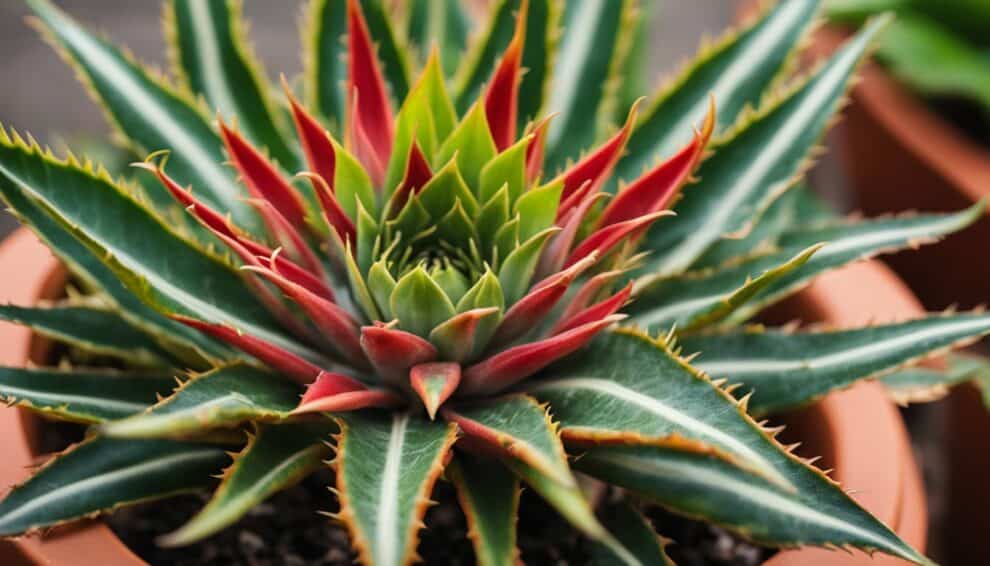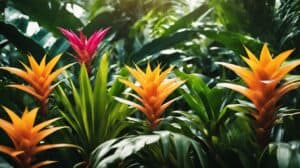Cryptanthus bivittatus, commonly known as Earth Stars, are a popular type of houseplant that are native to Brazil.
These plants are known for their unique, star-shaped rosettes and their ability to thrive in low light conditions.
Earth Stars are a great choice for beginners who are looking for an interesting and easy-to-care-for plant.

One of the most interesting things about Earth Stars is their unique rosette shape.
The leaves of the plant grow in a circular pattern, with each leaf curving upward to form a star shape.
This unique shape makes Earth Stars a popular choice for indoor decoration, as they add a touch of whimsy to any room.
Another interesting fact about Earth Stars is that they are epiphytic plants, which means that they grow on other plants instead of in soil.
This makes them well-suited for growing in pots with well-draining soil, as they don’t require a lot of water or nutrients.
Additionally, Earth Stars are known for their ability to thrive in low light conditions, making them a great choice for beginners who may not have a lot of natural light in their homes.
What Is Cryptanthus Bivittatus?
Defining Earth Stars
Cryptanthus bivittatus, also known as Earth Stars, is a species of bromeliad plant that is native to Brazil.
It is a small, low-growing plant that is often used as an ornamental plant in gardens and indoor spaces.
Earth Stars are known for their unique foliage, which is characterized by their star-shaped rosettes with thick, leathery leaves.
Species Overview
Earth Stars are part of the bromeliad family, which includes over 3,000 species of plants.
They are known for their ability to grow in a variety of environments, from tropical rainforests to arid deserts.
Cryptanthus bivittatus is a relatively small species, with rosettes that typically grow to be no more than 6 inches in diameter.
One of the most interesting features of Earth Stars is their ability to change color depending on their environment.
In brighter light, the leaves of the plant will often take on a reddish hue, while in lower light conditions they will appear more green.
This makes them a popular choice for indoor spaces, where they can be used to add a splash of color to any room.
Overall, Cryptanthus bivittatus is a fascinating plant that is well-suited to a wide range of growing conditions.
Whether you are an experienced gardener or just starting out, Earth Stars are a great choice for anyone looking to add some unique and interesting foliage to their collection.
Caring for Your Earth Star

Lighting Requirements
Cryptanthus bivittatus, also known as Earth Star, requires bright, indirect light.
It is recommended to place the plant near a north or east-facing window, where it can receive filtered sunlight.
Direct sunlight can scorch the leaves, so it is best to avoid placing the plant in direct sunlight.
Watering Tips
When it comes to watering, it is important to keep the soil moist but not waterlogged. Overwatering can lead to root rot, which can be fatal to the plant.
Water the plant when the top inch of soil feels dry to the touch. It is recommended to use room temperature water to avoid shocking the plant.
Soil and Repotting
Earth Stars prefer well-draining soil that is rich in organic matter. A mixture of peat moss, perlite, and sand is ideal for the plant.
Repotting should be done every two to three years, or when the plant has outgrown its current container.
When repotting, be sure to use a pot that is only slightly larger than the current one.
Temperature and Humidity
Earth Stars prefer temperatures between 60-80°F (15-27°C).
They also prefer high humidity levels, so it is recommended to place a tray of water near the plant or use a humidifier.
Avoid placing the plant near drafts or air conditioning vents, as this can cause the plant to dry out quickly.
Overall, Cryptanthus bivittatus is a low-maintenance plant that is perfect for beginners.
By following these simple care tips, you can ensure that your Earth Star thrives and adds a touch of green to your living space.
Propagation Methods

Offsets Division
One of the easiest ways to propagate Cryptanthus bivittatus is through offsets division.
These are small plantlets that grow from the mother plant’s base.
When the offsets are large enough, they can be separated from the mother plant and potted individually.
It is important to make sure that each offset has its own roots and leaves before separating them.
Once separated, the offsets can be planted in a well-draining soil mix and kept in a warm, humid environment until they establish roots.
Seed Germination
Another way to propagate Cryptanthus bivittatus is through seed germination. The seeds are small and can be collected from the mother plant’s flowers.
It is important to note that not all Cryptanthus bivittatus plants produce viable seeds.
The seeds should be sown in a well-draining soil mix and kept in a warm, humid environment until they germinate.
It may take several weeks for the seeds to germinate, and it is important to keep the soil moist but not waterlogged.
Once the seedlings have established roots, they can be transplanted into individual pots and grown until they are large enough to be planted in their permanent location.
Overall, both of these propagation methods are relatively easy and can be done by beginners.
It is important to keep in mind that Cryptanthus bivittatus is a slow-growing plant, so it may take some time for the plants to reach maturity.
With patience and proper care, however, these plants can be a beautiful addition to any collection.
Common Challenges

Pest Problems
Cryptanthus bivittatus is a relatively hardy plant, but it can still fall prey to a few pests.
One of the most common pests that affect Earth Stars is spider mites.
These tiny bugs can be difficult to spot, but they can cause significant damage to the plant.
Signs of spider mites include webbing on the leaves and a yellowing or stippling effect on the foliage.
Another pest that can harm Cryptanthus bivittatus is mealybugs. These small, white bugs can be found on the leaves and stems of the plant.
They can cause damage by sucking the sap from the plant, which can cause the leaves to wilt and yellow.
To prevent pest problems, it’s important to keep the plant clean and free of debris.
Regularly inspect the plant for signs of pests and remove any affected leaves or stems immediately.
You can also use insecticidal soap or neem oil to control pests.
Disease Prevention
Cryptanthus bivittatus is generally a healthy plant, but it can be susceptible to a few diseases.
One of the most common diseases that affect Earth Stars is root rot. This occurs when the plant is overwatered, and the roots become waterlogged.
Signs of root rot include yellowing and wilting leaves, as well as a foul odor coming from the soil.
To prevent root rot, it’s important to make sure the plant is not overwatered.
Allow the soil to dry out slightly between waterings, and make sure the pot has good drainage.
You can also add perlite or sand to the soil to improve drainage.
Another disease that can affect Cryptanthus bivittatus is leaf spot. This is caused by a fungus and can cause brown or black spots on the leaves.
To prevent leaf spot, make sure the plant is not overcrowded and has good air circulation. You can also use a fungicide to control the disease.
By taking care to prevent pest problems and diseases, you can help your Cryptanthus bivittatus thrive and enjoy its unique beauty.
Frequently Asked Questions

How do I care for a Cryptanthus Bivittatus plant?
Cryptanthus Bivittatus plants are relatively easy to care for, making them a popular choice for beginners.
They require bright, indirect light and well-draining soil.
It’s important to keep the soil moist but not waterlogged, as overwatering can lead to root rot.
These plants also benefit from occasional misting to increase humidity levels.
What are the different varieties of Earth Star plants?
There are several varieties of Cryptanthus Bivittatus plants, each with its own unique characteristics.
Some popular varieties include the black mystic, silver star, and red star.
Can you explain the propagation method for an Earth Star plant?
Propagation of Cryptanthus Bivittatus plants is typically done through division.
To do this, carefully remove the plant from its pot and gently separate the offsets from the parent plant. Each offset should have some roots attached.
Plant the offsets in their own pots with well-draining soil and water thoroughly.
What benefits do Earth Star plants offer?
Aside from their attractive appearance, Cryptanthus Bivittatus plants offer several benefits.
They are known for their air-purifying qualities, removing toxins from the air and increasing oxygen levels.
They also help to regulate humidity levels in a room, making them a great choice for those with dry indoor environments.
What are the typical size and growth expectations for Earth Star plants?
Cryptanthus Bivittatus plants typically grow to be around 6-8 inches in height and width.
They are relatively slow-growing plants, with new growth appearing at the center of the plant.
What color variations can be found in Earth Star plants?
Earth Star plants come in a variety of colors and patterns, making them a popular choice for those looking to add some color to their indoor space.
Some common color variations include shades of green, pink, red, and yellow, with patterns ranging from solid colors to stripes and spots.














